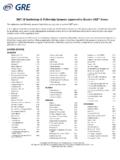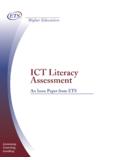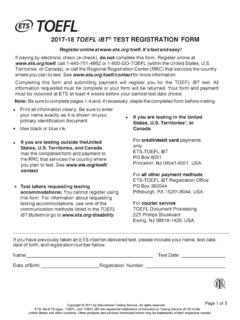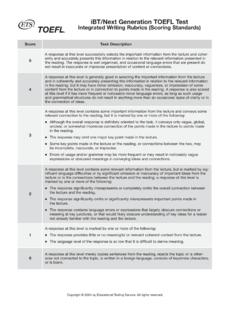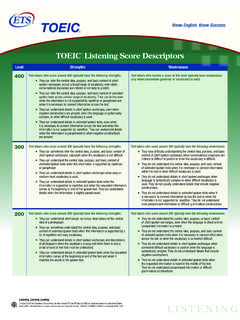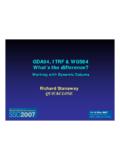Transcription of TOEFL iBT Quick Prep - ETS Home
1 Volume 2 TOEFL iBT Quick PrepGo anywhere from iBT Quick Prep2 IntroductionAbout the TOEFL iBT testThe TOEFL iBT test measures your ability to use and understand the English language as it is read, heard, spoken, and written in the university classroom. As the most accepted English-language test in the world, more than 8,000 universities, agencies, and other institutions in more than 130 countries accept TOEFL scores as part of their admissions order for the TOEFL iBT test to measure how well you read, listen, speak, and write in English, and how well you use these skills together, you will be asked to integrate these skills.
2 For example, you may read a passage or listen to a lecture, and then write or speak about what you TOEFL ibt Quick prep TOEFL iBT Quick prep can help you prepare for the TOEFL iBT test. All the questions in this Quick prep book are real TOEFL iBT questions given to examinees at worldwide test administrations, but some questions are presented differently than on the real prep includes questions from all four sections of the TOEFL iBT test: Reading, Listening, Speaking, and Quick prep , the Listening, Speaking, and Writing sections include written transcripts of the audio portions of the test.
3 If you have access to people with good English pronunciation, ask them to read the transcripts aloud to you. Listening to the transcripts is better practice than reading them to yourself. If someone reads the transcripts to you, make sure you see the pictures. As in the real test, you may take notes while you listen, and you may use your notes to help you answer the More inForMAtionFor complete information about what to expect on the test, how to prepare, and how to register, visit INTRODUCTIONC opyright 2011 by Educational Testing Service.
4 All rights reserved. ETS, the ETS logo, LISTEnInG. LEARnInG. LEAdInG., TOEFL and TOEFL iBT are registered trademarks of Educational Testing Service (ETS) in the United States and other countries. TOEFL -QP-0910 TOEFL iBT Quick PrepReading SectionThis section measures your ability to understand academic passages in English. You can skip questions and go back to them later as long as there is time begin the Reading iBT Quick Prep4 ReaDINg PRaCTICe SeT 1 Reading Practice Set 1: Passage and QuestionsDirections: Read the passage. Then answer the questions.
5 Give yourself 20 minutes to complete this practice oF the DinosAurs Paragraph 1 Paleontologists have argued for a long time that the demise of the dinosaurs was caused by climatic alterations associated with slow changes in the positions of continents and seas resulting from plate tectonics. Off and on throughout the Cretaceous (the last period of the Mesozoic era, during which dinosaurs flourished), large shallow seas covered extensive areas of the continents. data from diverse sources, including geochemical evidence preserved in seafloor sediments, indicate that the Late Cretaceous climate was milder than today s.
6 The days were not too hot, nor the nights too cold. The summers were not too warm, nor the winters too frigid. The shallow seas on the continents probably buffered the temperature of the nearby air, keeping it relatively constant. 2 At the end of the Cretaceous, the geological record shows that these seaways retreated from the continents back into the major ocean basins. no one knows why. Over a period of about 100,000 years, while the seas pulled back, climates around the world became dramatically more extreme: warmer days, cooler nights; hotter summers, colder winters.
7 Perhaps dinosaurs could not tolerate these extreme temperature changes and became extinct. 3 If true, though, why did cold-blooded animals such as snakes, lizards, turtles, and crocodiles survive the freezing winters and torrid summers? These animals are at the mercy of the climate to maintain a livable body temperature. It s hard to understand why they would not be affected, whereas dinosaurs were left too crippled to cope, especially if, as some scientists believe, dinosaurs were warm-blooded. Critics also point out that the shallow seaways had retreated from and advanced on the continents numerous times during the Mesozoic, so why did the dinosaurs survive the climatic changes associated with the earlier fluctuations but not with this one?
8 Although initially appealing, the hypothesis of a simple climatic change related to sea levels is insufficient to explain all the iBT Quick Prep5 ReaDINg PRaCTICe SeT 1 Paragraph 4 dissatisfaction with conventional explanations for dinosaur extinctions led to a surprising observation that, in turn, has suggested a new hypothesis. Many plants and animals disappear abruptly from the fossil record as one moves from layers of rock documenting the end of the Cretaceous up into rocks representing the beginning of the Cenozoic (the era after the Mesozoic).
9 Between the last layer of Cretaceous rock and the first layer of Cenozoic rock, there is often a thin layer of clay. Scientists felt that they could get an idea of how long the extinctions took by determining how long it took to deposit this one centimeter of clay and they thought they could determine the time it took to deposit the clay by determining the amount of the element iridium (Ir) it contained. 5 Ir has not been common at Earth s surface since the very beginning of the planet s history. Because it usually exists in a metallic state, it was preferentially incorporated in Earth s core as the planet cooled and consolidated.
10 Ir is found in high concentrations in some meteorites, in which the solar system s original chemical composition is preserved. Even today, microscopic meteorites continually bombard Earth, falling on both land and sea. By measuring how many of these meteorites fall to Earth over a given period of time, scientists can estimate how long it might have taken to deposit the observed amount of Ir in the boundary clay. These calculations suggest that a period of about one million years would have been required. However, other reliable evidence suggests that the deposition of the boundary clay could not have taken one million years.
